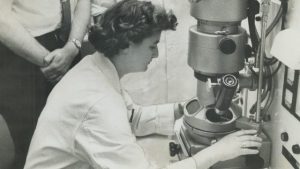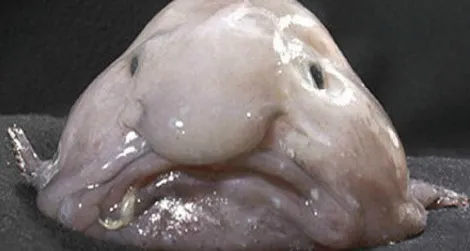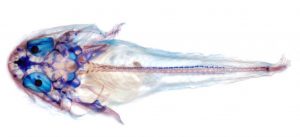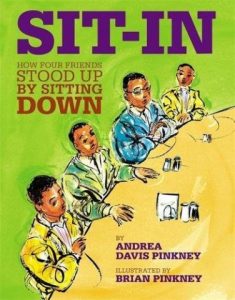Category: Parent/Guardian Resources
‘Invisible Worlds’: Who Discovered Coronavirus?

Have you ever heard of June Almeida? She was a Scientist interested in examining microbiology and viruses. She used microscopes to take photos of viruses and to learn about antibodies and the immune system. She took photos of the first known example of a human coronavirus, and her research was later used to help modern-day virologists learn about the COVID-19 coronavirus strain.
Here is a photo of June using an electron microscope.

There is a whole world that is ‘invisible’ to us unless we have the right tools to see it! Things like bacteria, micro-animals, and fungi are best viewed through a microscope!
Watch the video below to learn more about the teeny, tiny creatures that live in our world!
Remember: while things like viruses can make us sick, there are so many microorganisms that are harmless or even helpful to humans!
Learning at Home: Pumpkins, Lions, and Bears, Oh My!
In October, you might see some unusual produce in the enclosures of different zoo animals. Often, zookeepers will give the animals pumpkins. You can find lots of videos and pictures of different animals investigating, destroying, and even eating these pumpkins! But why do zoos do this? To find out, click to read the article below:
Skeletons and Sea-Creatures: Learning about the Blobfish!
Blobfish…Why the ‘World’s Ugliest Animal’ Isn’t as Ugly as You Think It Is

The blobfish is the world’s ugliest animal. But we don’t think the contest was very fair
Adapted from The Smithsonian, 2013
Poor sad blobfish, voted the world’s ugliest animal.
It’s that time again, when the whole world gathers together to pick on the blobfish.
Yesterday, after the votes were counted, the blobfish was named the world’s ugliest animal. The run-off was led by the Ugly Animal Preservation Society. The Society was looking for a mascot, an ugly mascot. As the Society says: “The panda gets too much attention. We want to see the uglier animals too!”
But we think the world was too hard on our friend the blobfish (or, if you want to call him by their proper name—and really, they’d prefer it if you would!—Psychrolutes marcidus).
Honestly, we think that droopy blobfish up there is actually holding up alright considering everything it’s been through. Psychrolutes marcidus are a deep water fish that live off the coast of Australia, somewhere between 2,000 and 4,000 feet beneath the waves. Down there, the pressure is up to 120 times higher than it is at the surface.
You wouldn’t want to be in the deep ocean without a strong submarine. And, likewise, the blobfish really doesn’t like being up here.
Many fish have something called a swim bladder, an organ full of air in their body that helps them move. When you take fish with swim bladders out of their natural habitats that air sac “may expand when they rise, which harms the fish”.
See what we mean about the blobfish having a hard time?
The blobfish doesn’t really have much of a skeleton, and it doesn’t really have any muscle. So, up here, it’s saggy and droopy. In fact, super-deep water fish often have minimal skeletons and jelly-like flesh. They are almost like a water balloon!

Image above: what’s inside a blobfish? The bones are dyed red, the cartilage is dyed blue. What do you notice?
So why do we think the world is too hard on the blobfish? Because if we put you 4,000 feet below the water your body and organs would be crushed and you’d probably become gooey and gross.
Meanwhile, the blobfish can withstand the deep sea. We think they are quite a lovely fish when they are left alone in their home.

Image: (left) the blobfish in the deep ocean look very different from the blobfish we usually see in photos (right)
Learning at Home: Writing Prompt
As we approach October, the month where we learn about all things superstitious, spooky, and scary, check out this video of a very ‘scary’ black cat. After watching the video, feel free to write about…
- What is something that terrifies you? Is this fear based on something (a memory, a movie, etc.)? What might happen if you had to face this fear?
- Why do you think black cats are considered ‘bad luck’? Many black cats are not adopted from shelters. What could we do to challenge this stereotype and help people love black cats instead?
- What was your favourite toy when you were younger? Do you still have it?
Important Reminders
Hello, families! Some important reminders for this week (we have also written these in our planners):
- Please return your Student Information sheets as soon as possible
- Please review and return the yellow Student Emergency Release form as soon as you can
- Sign up for Welcoming Conversations online. To make sure everyone is able to set a meeting, please only sign up for one ten minute time slot (per parent/guardian). Please contact Ms. Ward if you are not available during any of the remaining time slots!
- Please fill in the online survey if you have not done so already
- Early dismissal on Thursday
- Don’t forget to dress for the weather (rain or shine) and that photo day is this upcoming week!
Thanks everyone! I look forward to meeting with everyone (virtually) this week.
-Ms. Ward
Body Percussion: Rhythm + Self-Regulation at Lochdale!
This week, we have been practicing our rhythm, beat, and timing with our percussion coach, Daniel! He is a musician who specializes in drum styles and rhymical beats from across the world. So far, we have learned about a rhythm called a “Hambone” (a song often drummed and sung by African Americans across the Southern USA). We also talked about how we can use stomping, clapping, and jumping to help regulate our emotions and reduce stress.
Below is a video of a drumming prodigy. A “prodigy” means that someone is very talented at something at a very young age. Have you ever played the drums?
Learning at Home Activity: Observation Walks
Hello parents, guardians, and families of Division 5!
I’ve attached an optional (but encouraged) PDF of some themed observational walks that our students can do at home. These walks are intended to be taken with a parent/guardian/family (with all needed safety precautions in place) with a focus on observing, discussing, and identifying different themes.
Please feel free to do these walks at your leisure, and let me know what you observe! When we take time to slow down and notice things, it might surprise you what we miss on a daily basis!
Sourdough Science: Fermentation, Micro-organisms, and Bread!
Did you know that the bread we eat relies on different substances to help it rise? Often, we will use baking soda or baking powder. Sometimes, people will use yeast. But one of the oldest and most interesting ways to help bread rise is by using a levain, or sourdough starter/mother.
Check out this video to see the “secret Science” behind bread!
Black Shirt Day: Examining the Legacy of Segregation
Today, we read Sit-In: How Four Friends Stood Up By Sitting Down. This story was based on the real-life peaceful protests that took place in Greensboro and spread across the southern United States. Four young men, tired of being refused service at businesses because of the colour of their skin, sat down in a segregated restaurant and ordered coffee. Even when they were ignored, mocked, threatened, and attacked, they demonstrated patience and perseverance.

What began with 4 Black college students peacefully protesting against segregation quickly led to a movement across the U.S.A that inspired integration. Please feel free to watch the video clip below to learn more about the Greensboro sit-in movement.
Tomorrow, we will be discussing Dr. Martin Luther King Jr. and his legacy as a Civil Rights activist, and how his message of justice and equality is still as relevant today as it was during his lifetime.
Tomorrow, we can wear a black shirt to acknowledge everyone, both in the past and in the present, who takes a stand against racial inequality, prejudice, and injustice.
Tomorrow, we can reflect on how we (as individuals and as a community) can take steps towards equity.
